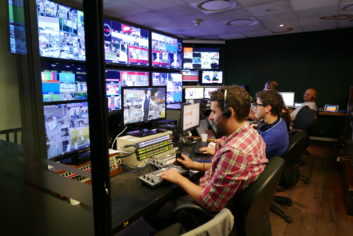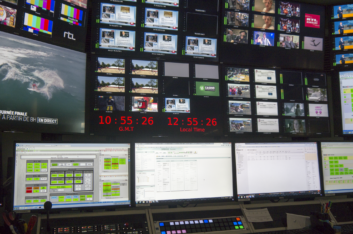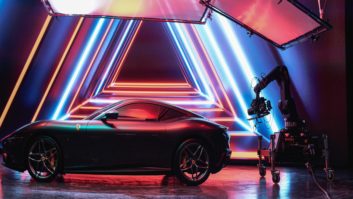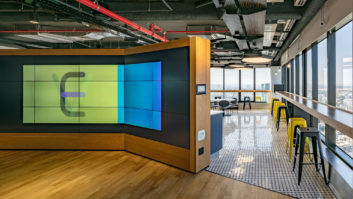The broadcast industry is constantly evolving. The modern consumer expects content that is of high quality, timely, and relevant. Moreover, they want to be able to enjoy content on the TV as much as on the phone. As tastes and technology change, so too must broadcast grow and adapt in order to satisfy the cravings of an ever more demanding audience.
 One challenge has been a rapid shift from traditional TV to digital, with the result that broadcast companies need to find ways to remain competitive in the face of streaming services like Amazon, Disney+, Netflix, et al.
One challenge has been a rapid shift from traditional TV to digital, with the result that broadcast companies need to find ways to remain competitive in the face of streaming services like Amazon, Disney+, Netflix, et al.
“The real challenge for the broadcaster” explains Jay Martin, VP sales, Dielectric, “is to serve an audience that is increasingly focused on ‘content on demand’ while considering that this audience will not necessarily be receiving on a traditional fixed device. The broadcaster is making a clear transition to the role of a content provider and supplementing the OTA (over the air) service with their own streaming platform.”
Brick Eksten, CEO, Qligent believes that by shifting toward VoD (video on demand) services, broadcasters can exploit valuable data. “Broadcasters have to move to a model where they can identify, manage, and service their audience in the same way as the VoD services. The ability to access key audience information will help broadcasters remain competitive from an advertising perspective, which is critical in the television model.”
So, by exploiting certain aspects of the OTT (over the top) model, broadcasters and their audiences can benefit from additional, more relevant content. In addition, broadcasters can benefit from a deep understanding of what the consumer wants through their industry experience.
“Traditional broadcasters know their audiences through decades of productions, and know what works, and what doesn’t,” says Craig Heffernan, technical sales director EMEA, Blackmagic Design. “The most significant cultural impact Netflix et al have had on the media industry is how audiences consume content. Broadcasters have all started to offer online content along with the ability to catch up, re-watch or binge shows online.”
Engaging experiences
Along with the shift in the way that content is delivered, how it is consumed has gone through massive change with the result that mobile devices can be used not just for viewing content but for generating and sharing it too. This creates opportunities for broadcasters to offer more engaging experiences.
“If there is one thing we have learnt as an industry from the Covid-19 pandemic, it is that we have to use all the tools at our disposal to get content distributed which is relevant, engaging, and entertaining,” says Rob Malcolm, chief product officer, Imagine Communications. “Remote production and operations is central to the argument going forward. When even the phones we all carry include UHD cameras and delivery systems, then the question moves beyond technology to how we can use it creatively within the bounds of audience expectations. Engaging experiences are all about the content: mobile technology allows more creativity in more places and with more immediacy.”
 Mobile devices also give broadcasters a great platform to engage with audiences through carefully targeted advertising. According to Martin, the mobile devices we all carry with us know exactly what we like, where we shop, where we are and, in some cases, what we are doing. “That makes targeted advertising the real revenue-generating business opportunity for the broadcaster. The ability to capture relevant audience information, and target advertising and content down to the viewer is something we anticipate that broadcasters will leverage to the best of their abilities moving forward.”
Mobile devices also give broadcasters a great platform to engage with audiences through carefully targeted advertising. According to Martin, the mobile devices we all carry with us know exactly what we like, where we shop, where we are and, in some cases, what we are doing. “That makes targeted advertising the real revenue-generating business opportunity for the broadcaster. The ability to capture relevant audience information, and target advertising and content down to the viewer is something we anticipate that broadcasters will leverage to the best of their abilities moving forward.”
Relevant content
Staying relevant and keeping the audience engaged is one thing, but with so many channels screaming for attention, broadcasters need to make a special effort to provide the content that makes the consumer choose them out of the competition. This can be done by creating and strengthening brand equity through strategic partnerships.
As Martin notes: “One very relevant example in the United States is Disney’s ownership of the ABC Television Network. So, ABC not only has the content they created and own through ABC Studios, but they also have the entire portfolio of Disney and Pixar movies and TV programs. These partnerships and acquisitions are vitally important to the OTT and streaming portion of the evolving broadcast landscape.”
The sheer volume and breadth of content available is another important factor according to Yvonne Monterroso, director of product management, Dejero. “Today’s audiences consume content more quickly and have a shorter attention span, hence the more high-quality content a broadcaster can produce, the better chance of audience retention. Another consideration is the ability to repurpose live content for editing or curation.”
For Malcolm, the biggest competitive advantage traditional broadcasters have over the large streaming giants is their knowledge of and local access to, the heartbeat of a nation. “They are best placed to capture the conversation to create compelling local content for local audiences. If you create
high-quality content that audiences love, they will beat a path
to your door.”
ATSC 3.0 advantage
Broadcast companies can also look forward to the ATSC 3.0 standard which will enable them to take advantage of technologies that were previously unavailable to them.
Nick Ma, CEO and CTO at Magewell, explains: “The earlier ATSC specification limited over-the-air broadcasters’ ability to embrace recent technology developments, leaving advances such as 4K, HDR, and HEVC compression as the exclusive domain of cable, satellite, and OTT providers. ATSC 3.0 opens the door for OTA broadcasters to adopt these technologies, enabling them to offer targeted advertising and interactive content.”
 The standard will co-exist with an internet-based back channel that will resemble a mobile app, with the ability to push live content, local weather alerting, graphics, and metadata, but as Ray Miklius, VP EMEA sales and channel programs, GatesAir points out, “it will take some creativity from the broadcaster on how to deploy, but ultimately ATSC 3.0 changes the broadcast landscape by providing richer services and a much better consumer experience”.
The standard will co-exist with an internet-based back channel that will resemble a mobile app, with the ability to push live content, local weather alerting, graphics, and metadata, but as Ray Miklius, VP EMEA sales and channel programs, GatesAir points out, “it will take some creativity from the broadcaster on how to deploy, but ultimately ATSC 3.0 changes the broadcast landscape by providing richer services and a much better consumer experience”.
It is worth noting that current ATSC 3.0 deployment plans are mostly limited to North America. On the other hand, 5G is already available to many of us and can enrich the user experience in several ways.
Eksten comments: “5G allows the broadcaster to enhance their delivery paths by bringing in bidirectional network access and data exchange in a parallel path to the inherently efficient ATSC 3.0 networks. This will allow broadcasters to create cable like services while delivering best of breed quality and latency through ATSC 3.0.”
5G means that the mobile network will no longer be a bottleneck to the quality of video that the viewer can receive, opening the door for 4K content consumption over mobile networks. Ma explains: “While the visual advantages of watching 4K on a small smartphone may seem negligible, it does create possibilities like viewers being able to interactively zoom in on subsections of the picture while maintaining HD-equivalent resolution.”
Adapting to change
The broadcast industry is adapting to changing consumer behaviour in innovative and exciting ways. Looking further ahead, we can expect to see some key differences in the broadcast landscape.
According to Monterroso, the path of the next five years has been hugely impacted by the pandemic. “Broadcasters have realised that remote and at-home-productions are more viable, cost-effective, and time-efficient than previously thought. Remote production and the use of portable devices will be adopted on a much larger scale, especially when 5G is in common use. Immersive technology will become the everyday.”
Of course, OTT is here is to stay, and broadcasters will need to both embrace the OTT concept while also establishing a stronger local or regional identity to adapt to a rapidly changing media consumption landscape.
Eksten believes that the integration of rich, mature, and context-aware data and interactivity into the broadcast delivery will fundamentally change how we think about TV. “It will allow the broadcaster to compete at the data/analytics level with the pureplay digital networks while having the advantage of efficient and scalable content delivery,” he says. “The convergence of networks, data, and computing will create new business models for the broadcaster.”
For Malcolm, the big change will be in the equipment that broadcasters use. “Moving from legacy broadcast connectivity to standardised IP has been a theme for a while now, but it will continue to drive transformation in everything we do. Broadcast and AV equipment will become almost entirely software applications running on COTS (common off the shelf) hardware. Microservice architectures will give installations unlimited flexibility.”
Virtualised software
Malcolm makes a good point. Traditionally, major broadcast and audio-video installations have been created to do a particular job, then left for a planned life of seven to ten years. The move to virtualised software on COTS hardware, on-premises or in the cloud, means installations are inherently flexible and scalable.
 As witnessed in 2020, when the focus was solely on finding solutions that would work in socially-distanced environments, it allows you to quickly build something and run with it. What might have been a proof-of-concept design rapidly became the on-air solution.
As witnessed in 2020, when the focus was solely on finding solutions that would work in socially-distanced environments, it allows you to quickly build something and run with it. What might have been a proof-of-concept design rapidly became the on-air solution.
Simon Browne, VP product management, Clear-Com, foresees other developments on the production side. “Within the production intercom world, faster and easily available cellular wireless connectivity will enable studio to outdoor venue continuous communication. As speeds increase,
latency issues subside and critical audio can be treated as network data.”
At the same time, Ma predicts enhancements for the consumer. “In many regions, the limitations of past broadcast standards have held back 4K content consumption, despite 4K consumer displays already being commonplace. The roll-out of these technologies should also drive 4K further into the mainstream.”
Broadcast/AV crossover
In many ways, the crossover between broadcast and pro AV is obvious. There are clear overlaps with display technology (UHD, HDR, WCG) and immersive audio, and also media and AV over IP infrastructures which will require standards and interoperability. Pro AV and broadcast systems are functionally and technically identical.
IP networking and connectivity; UHD and wide colour gamut creation, delivery and display; mixed environments of real and virtual elements in real time. All this and more is as relevant in the broadcast studio as it is in the stadium or exhibition hall.
This crossover is also apparent to Browne. “The growth areas in corporate AV and events has been a big part of Clear-Com. We do not see much distinction between AV and broadcast apart from the immediacy of the workflows and the portability of the products.”
Magewell is another company with a strong position in the broadcast market – in particular, at the production end of the broadcast chain – which is just as much a pro AV company.
“Many of our product lines are directly targeted at the pro AV space,” explains Ma. “As such, we are very heavily invested in the AV sector, and shows like ISE and InfoComm are just as important to us as IBC and NAB (which serve the broadcast/production space).”
As broadcasters become content providers, they have an opportunity to bring more viewers back to the fold. The good news for the broadcaster is the industry is seeing an influx of new and innovative technologies that bring over-the-air and OTT streaming closer together. At the same time, the consumer can enjoy relevant, high-quality content from an established and trusted supplier.







